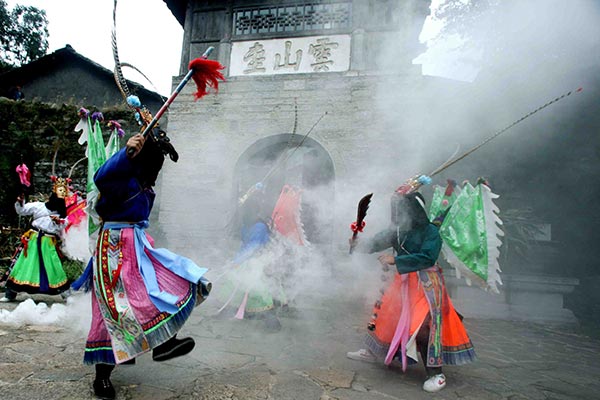
Wearing masks, villagers perform Dixi, a local drama and a national intangible cultural heritage item. [Photo/Provided to China Daily]
Along with features like Huanguoshu Waterfall and the karst cave Dragon Palace, Anshun in Guizhou province offers visitors the chance to explore preserved ancient villages.
The villages retain traditional features from more than six centuries ago and bring visitors a unique experience.
There are eight villages in Anshun that have changed little from 600 years ago when they were frontier posts. Every village looks like a fortress built of stone. Women in blue robes walk by muddy roads, Han descendants who first settled in the area during the Ming Dynasty (1368-1644).
When 200,000 soldiers set off from Nanjing - then the country’s capital in today’s coastal Jiangsu province in East China - and conquered Guizhou in 1381 after defeating the Mongol army of the former ruler, they did not return home.
Zhu Yuanzhang (1328-98), the first emperor of the Ming Dynasty, ordered the soldiers and their families - most of whom were from East China - to establish fortresses and defend the southwestern border of the newly built empire. Thirty percent of the soldiers remained on all-day military duty, the rest farmed and prepared for war.
In the following decades, 2 million more people from East China were relocated to the area to develop the local economy. These migrants didn’t marry locals and lived within their own neighborhoods, which they called tunpu.
Walking around the maze-like villages, it’s easy to appreciate how an outsider could get lost and how an invader would be likely to meet his end in the secret and security-tight fortress.

A preserved ancient village.[Photo by Li Lihong / for China Daily]
Seven watchtowers overlook each village. Peepholes are everywhere and functioned as an ancient version of closed-circuit TV monitors. Every house is linked with secret passages, through which residents can move around and exchange messages.
As time passed, the descendants of the original migrants have stayed in the same place even though there are no longer any posts or fortresses for them to guard. Even after the dynasty changed, their lifestyle remained the same.
Today, the villages are one of the top places for travelers to visit when in Anshun.
Despite thousands of visitors walking along the ancient stone paths, the villages remain well preserved.
“There are many changes that have come to our life, but some things are still the same,” said Fang Huinan who lives in Benzhai village, one of the best preserved in Anshun.
“Most of our traditions and cultures are exactly the same as 600 years ago, but in the modern age it’s inevitable to interact with the outside world, because we are part of it, too,” said the 27-year-old, who returned to her village and became a tour guide after graduating from a local college.
Fang said before the area’s growth in tourism, many young people tended to leave their villages. However, most of them have now chosen to come back as the tunpu has a more promising future.
Tourism has given people from the once poverty-stricken area the chance of a better life. The tunpu’s local culture and traditions in handicraft, drama and architectural style have become a huge draw to tourists.
Preservation and restoration of the style and features of the villages has become a top priority for the Anshun city government. A total of 140 old buildings in Tianlong Tunpu were restored in January and another 70 were finished in late May.
“We spare no efforts to restore the primitive style and features of tunpu culture,” said Yao Xingcan, an executive at Guizhou Tourism Investment Group, which was in charge of the project.
“It’s good to see our village and culture is becoming known by more people from around the world, and it also makes us proud of our history,” Fang said.
